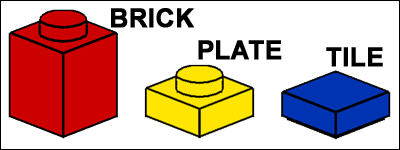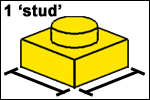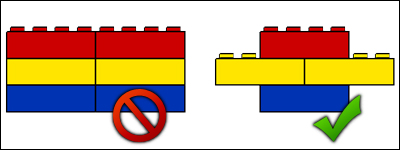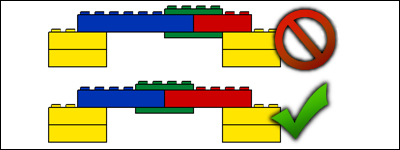|
|
|
Article 00001 - Back to Basics
For those who are new to LEGOs, this is an article filled with basic facts and techniques about these small, yet very versatile plastic bricks. For those who aren't much for reading there are plenty of pictures to show you the way.
Bricks, Plates, and Tiles
There are many different types of LEGO pieces out there. Aside from obvious things like wheels and windows, the main pieces to know are bricks, plates, and tiles.
Bricks are the pieces everyone knows. They are the backbone of LEGOs and are used in almost every model you make. Bricks are used a lot in larger models to take up space and support the model.
Plates are the flat pieces that hold models together without taking up a lot of room. They can also be used to create stripes or make simple platforms. Smaller models use a lot of plates in different colors to create different appearances.
Tiles are just like plates but they are smooth on top. They are mainly used for stickers on top of models or sometimes turned to the side. Tiles are also useful to make pieces move past each other such as a sliding door or under a turning object.

Size
LEGO pieces come in many different sizes.
 They are usually identified in size by the number of "dots" or "studs" with the smaller number first such as a 2x4 (two-by-four) brick. In size, a stud represents the area of a 1x1 brick or plate. Even if studs are not present, or there are less of them, the size of the piece is still said as the amount of studs it takes up. They are usually identified in size by the number of "dots" or "studs" with the smaller number first such as a 2x4 (two-by-four) brick. In size, a stud represents the area of a 1x1 brick or plate. Even if studs are not present, or there are less of them, the size of the piece is still said as the amount of studs it takes up.
Height is represented by the height of bricks. A brick has a height of 1 (one). A plate or tile has a height of 1/3 (one-third). For example, a piece that is as high as one brick plus two plates is said to have a height of 1 2/3 (one and two thirds).
Puttin'em Together
There is practically an unlimited number of ways to combine LEGO bricks. Besides just putting pieces on top of each other many pieces can be put together sideways or even upside down. The limit is your imagination!
Below are a few different examples of how LEGOs can be combined.
 Sturdiness is key in LEGO models. Interlocking pieces helps to keep your models strong!
Sturdiness is key in LEGO models. Interlocking pieces helps to keep your models strong!
 When spanning large gaps use long pieces to cover the entire gap. If a single piece can't make it, use two pieces that meet in the middle of the gap and link them together with other pieces. It will make your model look more uniform.
When spanning large gaps use long pieces to cover the entire gap. If a single piece can't make it, use two pieces that meet in the middle of the gap and link them together with other pieces. It will make your model look more uniform.
|
|
|


 They are usually identified in size by the number of "dots" or "studs" with the smaller number first such as a 2x4 (two-by-four) brick. In size, a stud represents the area of a 1x1 brick or plate. Even if studs are not present, or there are less of them, the size of the piece is still said as the amount of studs it takes up.
They are usually identified in size by the number of "dots" or "studs" with the smaller number first such as a 2x4 (two-by-four) brick. In size, a stud represents the area of a 1x1 brick or plate. Even if studs are not present, or there are less of them, the size of the piece is still said as the amount of studs it takes up.




